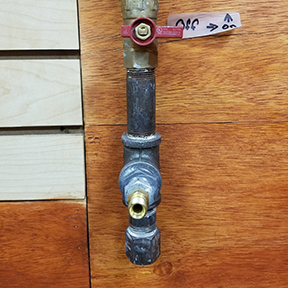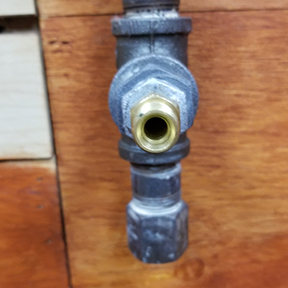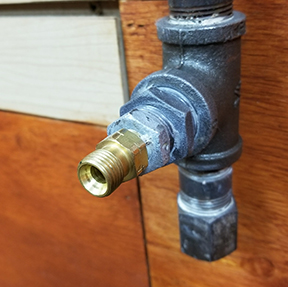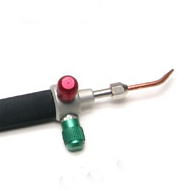Now that you are ready for Big Girl Torch
After much consideration and some research I decided that the most economical approach to getting into a professional torch was natural gas. But is it? Welllllll, I am still unclear.
If you are ready to join the big girls and upgrade from handheld butane torches here is what I have come to discover through research and experience.
There are many gases and as many arguments for and against each one of those gases. Most jewelers will opt for either propane, acetylene, or butane. (Unless you are a glass worker, Mapp is usually not part of this conversation.) If you are one of the unusual people then you will have natural gas, like me.
The argument for butane. I have actually heard the following argument so bear with me. You should use butane because it is a cleaner burning, greener gas. Really? Cleaner yes, but greener? You can not buy butane in larger refillable cans. You can only buy disposable cans. So my question is, you would trade off how many cans? to landfills versus the minor molecules that you are putting into the atmosphere? Really? Your choice but I call cow manure. But that is a personal choice. Most people who are using butane torches do it for the convenience and the perceived “safety” and the self-ignite mechanism of those torches. I have been successfully using butane for over 10 years. Some would argue that butane does not work, well, just look at my portfolio.
Then comes propane vs. acetylene. Which? There is a temperature difference between them, but for all practicality they are more or less the same when are talking about jewelry making. The argument for or against is in the soot. Acetylene is considered to be quite dirty, which means that your studio will suffer its consequence. Both gases require a tank of some sort. For most people it would be an “R” Size tank which needs to be refilled at the local welding/gas company.
What about natural gas? Why would you go this route? If your home has natural gas, then this is a viable option. Coupled with an oxygen concentrator you will never have to refill anything. Natural gas is a greenhouse gas, however, a clean burning one, which puts it into the realm of propane.
How do all of these work?
First and foremost, a torch. For any of the gasses, the torches are specific to the gas. However, many times the propane can be used with natural gas, you will want to check with the manufacturer. (Just call them, this is a simple question with a simple answer, they have ALL been easy to talk to.) The torch you purchase (aside from the gas determination) is determined by the kind of work you want to do. If you are benching vs. casting there are all different kinds of sizes to consider.
Once you have a torch, then comes the tank or not. There has to a gas source from somewhere. The most common being tanks. When you purchase a tank, don’t get all attached to that new shiny tank and don’t expect it to come filled. It will come empty (sort of illegal to ship filled). Once you receive it, you will need to go the local gas/welding company and ask them to “fill” it. But they really don’t fill it, they hand you one of theirs of the same size. Essentially, you are swapping the tanks like you do the propane tanks for your grill. (Say bye-bye to your new tank.)
The other option for attaining gas is to have it piped in. Whether it is from your 200gallon propane tank outside or from your natural gas line from the street, both are viable options. If you are already have gas from one of these two sources call the local hvac guy to add a line to your studio. What you need to be aware of here is the PSI. In a residential natural gas situation it can not be adjusted from the gas company (but in a commercial location it can be, for the most part). The key to this installation is the pressure. You will need anywhere from 5-8PSI. If you tell the hvac person this, they will likely laugh at you. But this is real, I promise. More than likely they will not be able to help. You will need to purchase a natural gas booster. http://www.gas-tec.com/TB15TB30.html (Unfortunately, I don’t know the pressure of a propane tank, but if it does not reach the correct PSI you will need a gas booster also.)
You have your torch and your gas, now you need oxygen, or not. By adding oxygen the temperature will go up significantly and you will be an even happier jeweler. But if that scares you, consider just air. Which means that the torch your purchase has only one hose and it brings in (sucks in) the ambient air to make it work. Butane torches work in this manner. Choosing to go with oxygen means you must choose between a tank system or a concentrator (a machine that makes the oxygen). If you choose a tank you should consider a flashback arrestor. This little device basically keeps the flame from going back down to the tank and well, exploding. According to my research, you will not need this with an oxygen concentrator and piped gas.
Lastly, the ignite. Most people using a butane torch like because it feels safer. The cans are smaller and the torches self-ignite. For the other systems you will need to find some sort of ignite mechanism. There are quite a few choices out there. Unfortunately, this will boil down to comfort. Hard to say which will be best for you.
All that said, this is how I set up my studio.
I continue to teach on butane even in my studio because most people have the same torch. This will allow them to be more comfortable in their own studio. I had an HVAC guy come run a pipe from one side of the house to the other ($150) where my studio is located. At the termination he installed a shut off valve and a brass connector. I hooked up my gas hose to the termination, the oxygen to my oxygen concentrator and voila! I was up and running. No booster.
Of course that was not enough for me. I started experimenting with casting. It didn’t work. Turns out you need a “rose bud” torch. It sort of worked. This is when I discovered that I needed more pressure. To date I have not purchased a booster ($1500) because things have worked fine without it and casting is not a priority.
So that’s it. That is all I know. I am getting ready to repeat this process again because I moved my studio. Check back in a few weeks and I will report on how that went.
The connection for the gas line.
 |
 |
 |

